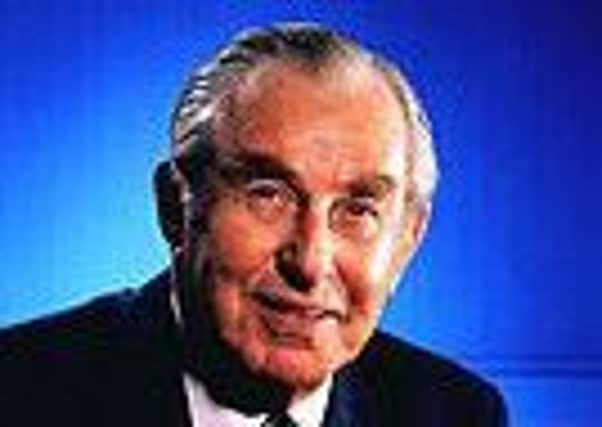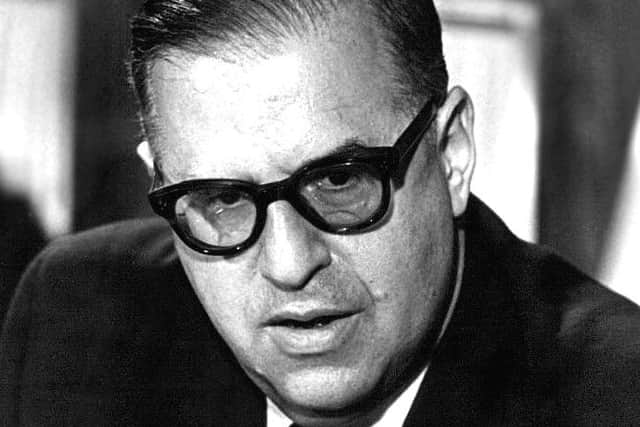Giants of Israeli politics both sprang from Belfast's tiny Jewish community


Chaim Herzog, the sixth and longest serving president of Israel, was born in Belfast on September 17 1918 but grew up in Dublin because in 1919 his father, Rabbi Yitzhak HaLevi Herzog, moved there on becoming chief rabbi of Ireland.
Yitzhak HaLevi Herzog was born in Łomża, Poland, and Sara (née Hillman), his mother, had been born in Latvia.
Advertisement
Hide AdAdvertisement
Hide AdYitzhak HaLevi Herzog became the first chief rabbi of Ireland in 1921. From 1936 until his death in 1959, he was Ashkenazi Chief Rabbi of the British Mandate of Palestine and of Israel after 1948.


After attending Wesley College in Dublin, Chaim emigrated to Palestine in 1935. There he studied at the Merkaz HaRav and Hevron yeshivas (a yeshiva is a Jewish educational institution offering classes in the study of the Talmud and the Torah), and enlisted in the Haganah, a Jewish paramilitary organisation in the British Mandate of Palestine, which later became the nucleus of the Israel Defence Forces (IDF), a year later.
In 1938 Chaim went to England to study law at University College, London. He subsequently qualified as a barrister at Lincoln’s Inn.
Having completed his studies, he volunteered for service in the British Army in 1942 and was commissioned as an officer. After serving as a tank commander, he became an intelligence officer, participated in the Normandy landings and was among the first troops to enter Nazi Germany.
Advertisement
Hide AdAdvertisement
Hide AdHerzog was involved in the liberation of the Bergen Belzen concentration camp, and as an intelligence officer took part in the interrogation of Heinrich Himmler. He left the Army in 1947 with the rank of major.
In 1947 he rejoined the Haganah, and with the formation of Israel in 1948, Herzog served in the first Arab-Israeli war and became head of military intelligence, a position he held until 1950 and again from 1959 to 1962. He retired from the IDF with the rank of major general in 1962 to practice law.
As a result of his radio broadcasts during the Arab-Israeli Six-Day War (June 5-10 1967), Herzog became one of the country’s pre-eminent political and military commentators, and was appointed the first military governor of the West Bank after its capture during that conflict.
As ambassador to the United Nations (1975–78), he waged a vigorous but unsuccessful campaign to defeat General Assembly Resolution 3379 that equated Zionism with racism.
Advertisement
Hide AdAdvertisement
Hide AdIn the course of a celebrated speech he symbolically tore up the resolution and declared: ‘For us, the Jewish people, this resolution based on hatred, falsehood and arrogance, is devoid of any moral or legal value. For us, the Jewish people, this is no more than a piece of paper and we shall treat it as such.’
This incident recalled a virtually identical episode 40 years earlier involving his father. In May 1939, shortly before the Second World War, the British published a White Paper restricting Jewish emigration to Palestine. On the steps of the Hurva Synagogue in the Old City of Jerusalem, Yitzhak HaLevi Herzog declared: ‘We cannot agree to the White Paper. Just as the prophets did before me, I hereby rip it in two.’
In 1981, as a member of the Israel Labour Party, Herzog was elected to the Knesset (the Israeli parliament). Two years later he was nominated as president, a largely ceremonial post. Although the right-wing Likud Party controlled the Knesset, Herzog’s widespread popularity led to his narrow victory. In office he expanded the role of the president and did much to enhance Israel’s international prestige and profile. In 1988 he was elected unopposed as president for second term, the maximum allowed under the Israeli constitution.
A keen historian, Herzog wrote extensively on Israeli history. His autobiography, Living History: A Memoir, appeared in 1996. He died the following year on April 17.
Advertisement
Hide AdAdvertisement
Hide AdChaim Herzog’s life exhibits a striking series of parallels with that of Abba Eban, the Israeli diplomat and politician, and scholar of the Arabic and Hebrew languages.
As a diplomat Eban served as Israeli ambassador to the United States and to the United Nations (1950-1959). He became vice president of the UN General Assembly in 1953. As a politician, he served as Israeli foreign minister (1966-74), minister of education (1960-63) and deputy prime minister (1963-66).
He was born in Cape Town, South Africa, in 1915 but his family moved to the United Kingdom at an early age and his formative years were spent with relatives in Belfast. He lived close to the Herzogs in north Belfast.
Eban and Herzog became firm friends. Both were scholarly men. Eban was educated at Cambridge, where he took a triple first in oriental languages, outstripping all comers in Hebrew, Arabic and Persian. Both served as intelligence officers in the British Army during the Second World War.
Advertisement
Hide AdAdvertisement
Hide AdBoth were drawn to Palestine, where they contributed their outstanding talents to the Zionism. Both rose to the highest diplomatic rank possible in the new state of Israel, representing their country at different times in the United Nations.
Eban became Israel’s first UN ambassador in 1948, and two years later served also as ambassador to the US. Herzog took up that position at the UN in 1974, when Israel was internationally isolated in the aftermath of the Yom Kippur War.
Herzog became president of Israel in 1983. Eban was for eight years Israel’s foreign secretary and was for a time deputy prime minister.
These two men, right at the heart of Israeli politics for over four decades, even married sisters. Eban married Suzy Ambashe, from a distinguished Jewish family living in Egypt. It was through his former neighbour off the Cliftonville Road, that Chaim Herzog met his wife, Suzy’s younger sister, Aura.
Advertisement
Hide AdAdvertisement
Hide AdIt is absolutely extraordinary that these two figures that were to play such a prominent and pivotal role in the rebirth and development of the state of Israel, a state which had disappeared from the face of the earth for 2,000 years or so, should have both had their roots in Belfast’s tiny Jewish community.